I’ve been up in my rainy “fort,” the open air, half-roofed lookout over the laundry shed, piles of soggy New Yorkers and Gardens Illustrated at my side, overindulging in a reading feast this blessedly stormy weekend. A copy of conversations with Robert Irwin, “seeing is forgetting the name of the thing one sees” has managed to stay semi-dry, and there’s also an assortment of other stuff I alternately pick up and put down, foraging for some badly needed inspiration. I found a couple pieces on the blog from several years back that coincidentally also feature Mr. Irwin in one guise or another.
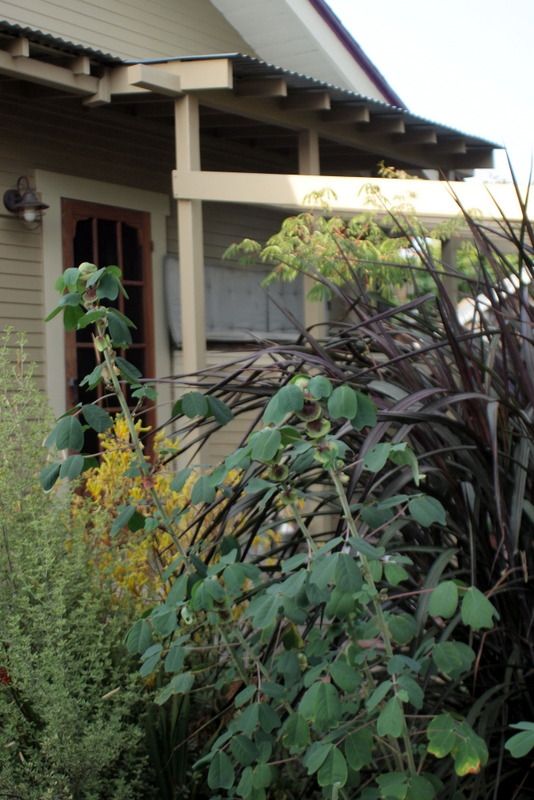
photo of lookout/rainy day fort from sunny August 2012. Coincidentally, Amicia zygomeris has been ordered and planted again for 2017
So just a quick hello, wishing you a happy Sunday and offering a couple accounts of some local jaunts in case you’re in need of some rainy day reading as well.
Following is a repost from August 2012 “melianthus at the getty and other controversies.”
The incomparable Herb Ritts and Titian were also at the Getty Center in Los Angeles, and some of Marie Antoinette’s hand-me-down furniture too. I think it can be safely said that gardeners are connoisseurs of the perfect moment, and last Sunday was that most exquisite of summer days, not too hot, just senusally warm and breezy, appreciated even more today for the fleeting rarity it was now that this week has brought the first real heat wave we’ve had this summer, along the coast at least. I’ve had such a strong itch to get to a museum lately. Must be all the press about the new *Barnes museum that’s been trickling in since its unveiling this spring in Philadelphia, which I hear includes a garden also, though there’s been little press so far about that. What few photos I’ve seen of the new Barnes’ garden depict a contemplative, austere space, the antithesis of Robert Irwin’s kinetic, kaleidoscopic maze at the Getty Center (to distinguish it from the Getty Villa in Malibu). But the controversy surrounding the new home of the Barnes Foundation reminds me of the raging controversy that Irwin’s garden for the Getty provoked at its unveiling in 1997.
And then there’s art controversies of the compound leafy kind. Here’s the melianthus in question. With those narrow leaflets, it’s definitely not M. major, and I’m inclined to think it’s M. comosus.

One of the lazy assumptions I’m inclined to make, and unfortunately there are many, has been to assume that the other species of melianthus are not really worth growing if you can have M. major, but this one at the Getty might be changing my mind. Slimmer leaflets, not as lush but a little more succulent in feel, create an even stronger rhythmic pattern. I’m pretty sure the dense effect must have been obtained by cutting it back hard, because although it’s reputedly smaller in size than M. major, it does tend toward lankiness. (San Marcos Growers: “This plant looks best if pruned hard and is often treated more like a perennial than a shrub.”)

The melianthus was planted at the top of the walkway leading down to the maze. This sylvan walkway flanking a tumbling stream is redolent with the fragrance of the London Plane trees lining either side, that strong scent of sycamore which to me will always be the perfume of summer and rivers.
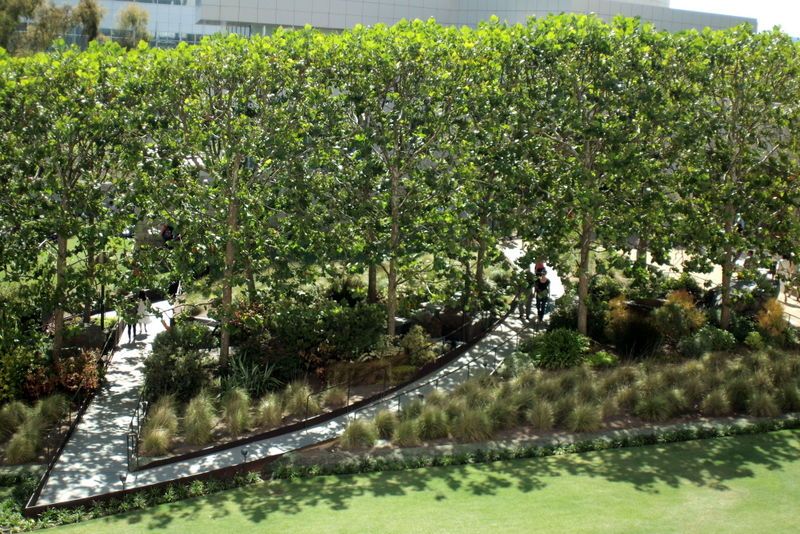
The stream hidden by the London Plane trees runs the entire length of the garden, ending in a dramatic spill into the azalea labyrinth.
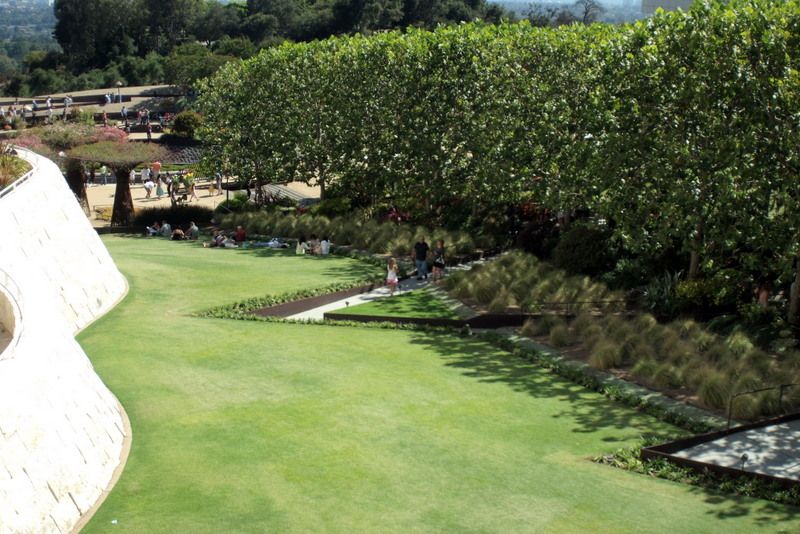
At the top, under the dappled shade of the sycamores, the Cor-Ten-bounded walkway plantings are filled with the strong leafy shapes of succulents, begonias, hellebores.

Hirsute Echeveria setosa, silvery dyckias, paddle plant Kalanchoe luciae, and a few blades of ophiopogon, the Black Mondo Grass.
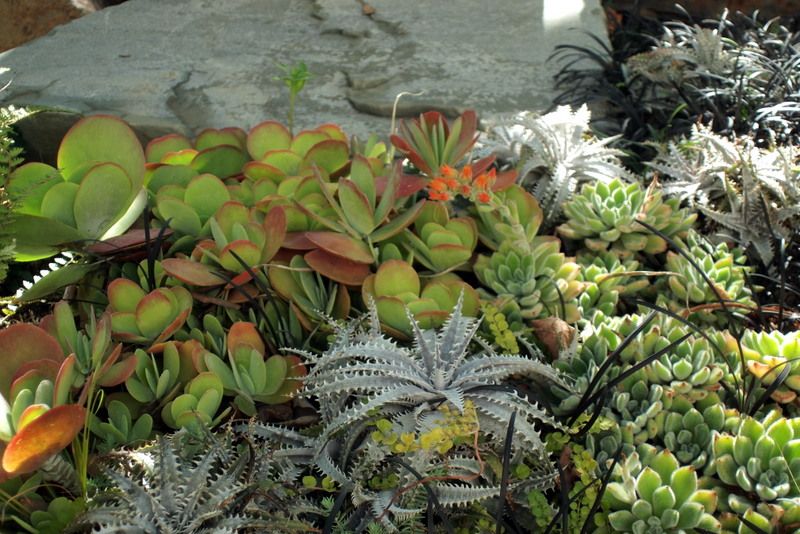

Begonias and variegated ginger

Astelia and persicaria

That lovely sycamore scent eventually gets supplanted by the overpoweringly skunky notes of variegated tulbaghia as you descend down the walkway toward the Central Garden. The mass planting of society garlic shimmering in the shifting light amidst the slender trunks of crepe myrtle trees is an undeniably powerful effect after the complex plantings of the upper walkway.

The improbable azalea maze in blinding full sun. Cotinus ‘Golden Spirit’ on the left. Purple blur in the distant background on the left is tibouchina, the princess flower, whose leaves were burning in the strong sunlight. The maze garden started looking its best towards closing time at 5:30 p.m. During the summer, this Getty is open til 9 p.m. on Fridays and Saturdays.
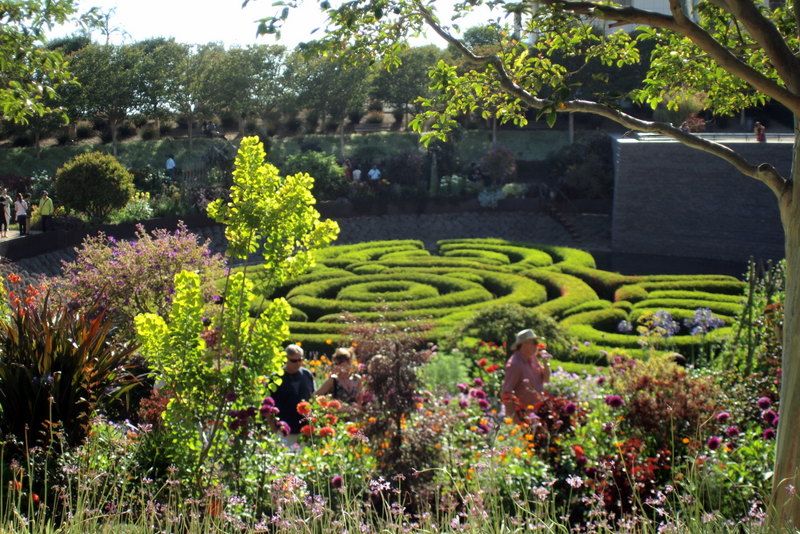
I can’t say the summer plantings of mostly dahlias were my favorite part of the garden, probably because I had just seen dahlias grown to perfection under the kinder skies of the Pacific Northwest. The effect was more of a shabby cutting garden, but the public seemed happy enough with the results. Irwin’s design calls for these labor-intensive, concentric borders surrounding the azalea pool to provide a triumphant and dizzying swirl of shape and color under a strong Mediterranean sun, and that’s a tall order. I think it’d be fantastic as a semi-desert garden, but the public might call foul. Art critic Christopher Knight had this to say about Irwin’s “folly” when it faced a barrage of criticism at its unveiling over a decade ago, and not for the plantings but for its very existence and the exuberant, almost comic contrast it presented to Meier’s stark, monumental architecture: “The great thing about a garden folly is that it’s, well, a folly. In a world of practical decorum, rationalism suddenly doesn’t apply. When the folly is conceived as the garden itself, rather than a discrete structure within a garden, then be prepared to suspend every expectation.” (Quote obtained here.)
On the path behind the massed society garlic, overlooking brugmansias, cannas, and a pomegranate tree to the giant bougainvillea rebar arbors.
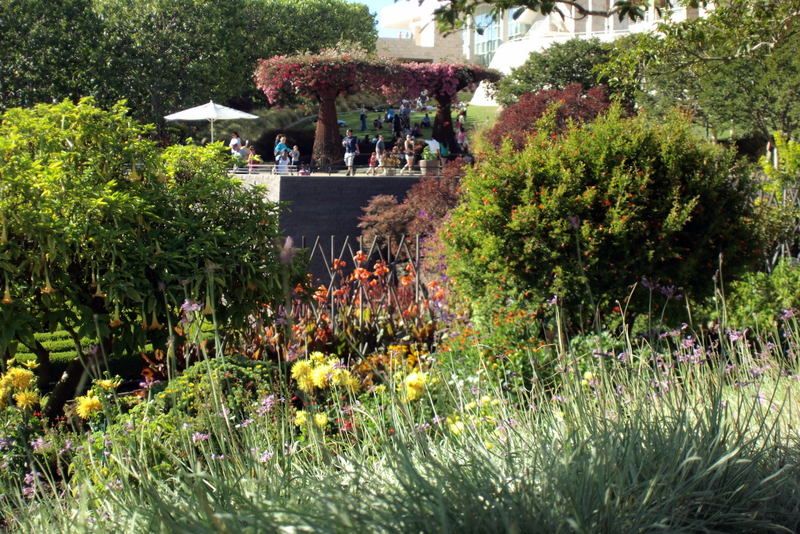
Always fascinating to uncover the multiple, shifting perspectives in Robert Irwin’s garden.
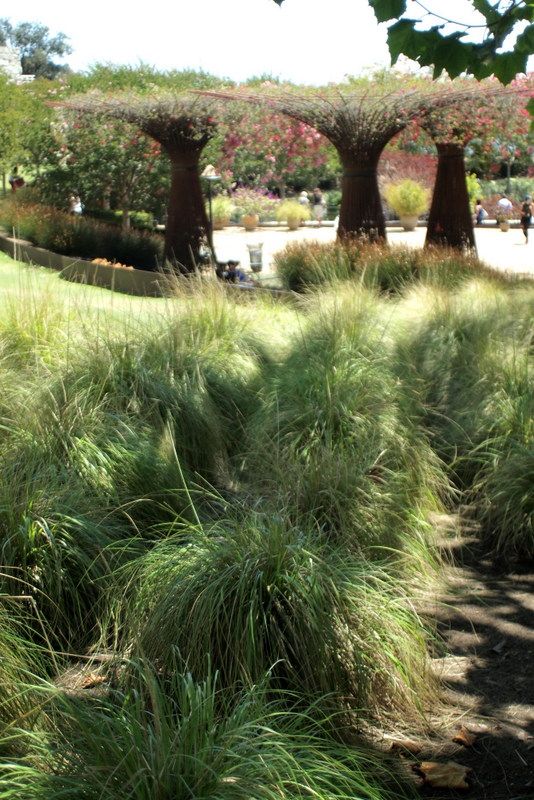
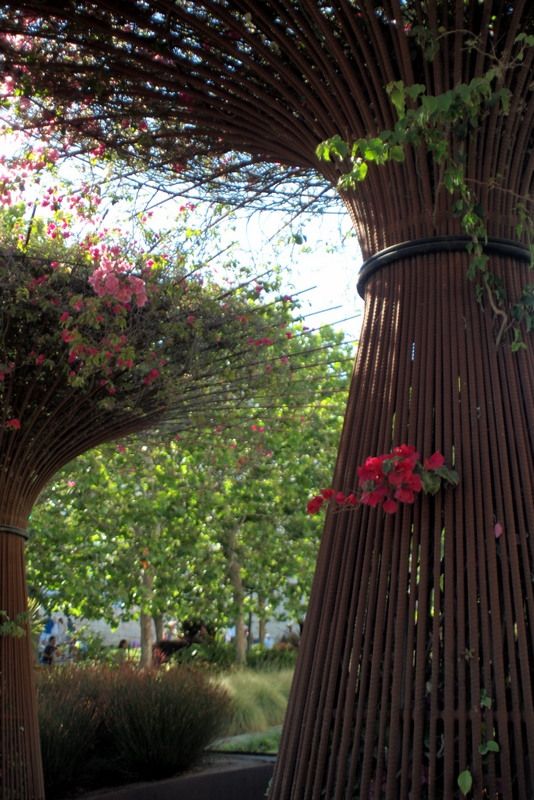
This visit I was struck by the sensitive treatment of trees, whether silhouetted against Meier’s exquisite travertine limestone or weeping into clean-swept expanses of decomposed granite, like these California pepper trees.


On the upper terraces closer to the museum, a bank of large pots massed together were planted simply and effectively with tough, scrubby stuff like helichrysum and Pelargonium sidoides.

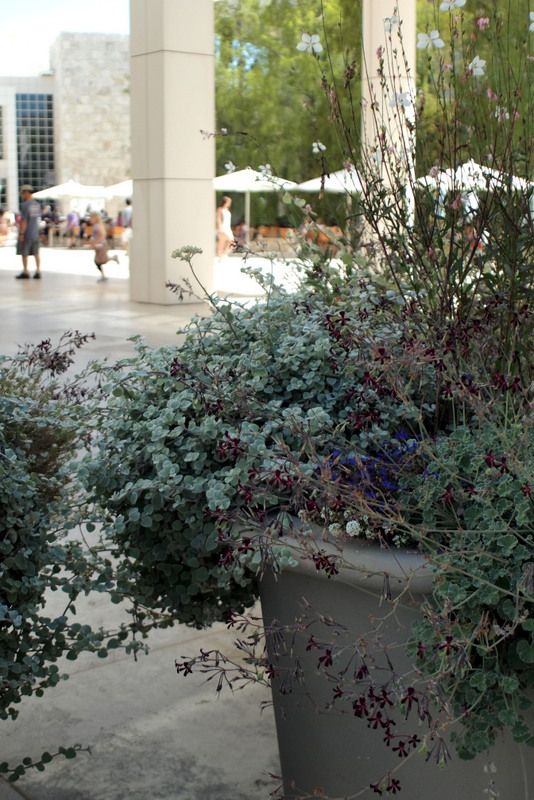

Museum fatigue usually hits me after an hour or so, but not this day. Even after five hours, I had to be reminded by security guards that the museum was closing and it was time to get a move on. The Herb Ritts photography exhibit closes September 2, 2012.
*Christopher Knight, art critic for the Los Angeles Times, is one of the diehard defenders of Albert Barnes’ original vision for his art collection. His review of the relocation of the collection to a new building in Philadelphia includes some helpful context for some of the timeless issues encapsulated in the debate over the Barnes collection: “Typical museums juxtapose art objects according to traditional knowledge categories like period, style or place. Not Barnes. His irreverent inventiveness used formal qualities — physical context, color, line, composition, texture, scale, space, etc. — to jump-start imagination. The result demanded that a visitor look and look hard.”
For more background on the Barnes, here’s a trailer to the controversial documentary entitled “The Art of the Steal.”
More of Robert Irwin’s work at LACMA, from August 2011 “Palms & Lawn” at this link.

Wasn’t the rain wonderful?! It seems you found a good place to enjoy it and lots of reading to engage you when your mind wandered back from the raindrops.
Haven’t been to the Getty for quite a while. That 405 construction was miserable. I think I remember reading Elon Musk donated a bunch of money to get it done sooner.
Big fan of rebar. Lends itself to all manner of gardenly things and largely wasted in concrete where it eventually blows it apart. Didn’t realise the original rebar/bougie trellises were at LACMA. Robert Irwin seems to be the real deal. Good ol American hog stomping Baroque by the looks of it. That azalea maze must be the vision splendid in early spring.
@Kris, and predictions for more this coming week. So it seems the best approach to encouraging rain is to let it sneak up on you 😉
@Hoov, I can’t remember when the 405 wasn’t a misery. The Meditt Garden Society was meeting there a couple weeks ago too — so tempted.
@Ross, I’m a big fan too, having just employed a bit of rebar for a trellis for a passiflora, but a very modest three-leg trellis!
I gave up on the 405 in the mid-1980s. Went to pick someone up at the airport at two in the morning, and — *voila!* — a backup that rivaled rush hour.
I have mixed feelings about Irwin’s Getty garden. The intensive maintenance required for those Platanus to me seems the wrong choice for the dappled shade effect desired. Why not choose a tree closer to that character without all the work? The ground level plantings also seemed very forced to me, combinations chosen for an intended look, rather than combinations with plants that enjoy similar growing conditions. It just strikes me as flawed to treat plants as disposable objects, a great planting design to me works on multiple levels, not just as “paint” colors.
I know when I toured this garden with the garden group “The Hortisexuals” back in 2000 or so, many fellow plants people and landscape designers in our group also faulted the Irwin garden for similar issues. The contrast with the other parts of the Getty garden with the classic modernist understated landscape couldn’t contrast any more with the central space. That roof top promontory with all the cacti and Euphorbias is probably my favorite detail, although I’ll admit those giant regarding “trees” with the Bougainvillea are fun too.
@Nell, but now it’s new and improved! Except still packed with stalled cars…
@David, those are all valid criticisms. I will say that this kind of detailed planting, while probably common in the Bay Area and likely much better done, is so unusual in SoCal that it instantly won local affection.